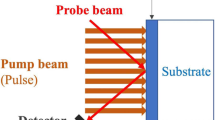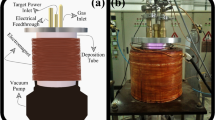Abstract
In the present work, microwave heating characteristics of a few selected bulk metallic materials were studied in the ambient environment using 1400 W input microwave power at 2.45 GHz. Interactions of microwaves with the three target metallic materials—aluminum, copper and stainless steel and their effects were elucidated using the time–temperature profiles monitored during microwave hybrid heating. Metal oxides formed at different stages of the exposure were characterized using scanning electron microscopy and other X-ray-based techniques; role of the oxides in the heating behavior has been explained. The results revealed that heating of the target materials get influenced by the metallic oxides formed on the exposed surfaces of the metallic materials. The oxide layer reduces heat transfer between the susceptor and metallic material at initial stages of heating; however, it assists microwave absorption in the metallic materials depending upon its electromagnetic properties at elevated temperatures during irradiation. The oxide particles act as tiny susceptors initially, which, however, turn into secondary sources of conventional heating in the target material during hybrid heating.












Similar content being viewed by others
References
Oghbaei M, Mirzaee O (2010) Microwave versus conventional sintering: a review of fundamentals, advantages and applications. J Alloy Compd 494(1):175–189
El Khaled D, Novas N, Gazquez JA, Manzano-Agugliaro F (2017) Microwave dielectric heating: applications on metals processing. Renew Sustain Energy Rev 82:2880–2892
Gupta M, Wong WLE (2005) Enhancing overall mechanical performance of metallic materials using two-directional microwave assisted rapid sintering. Scr Mater 52(6):479–483
Roy R, Agrawal D, Cheng J, Gedevanishvili S (1999) Full sintering of powdered-metal bodies in a microwave field. Nature 399(6737):668–670
Lee CC, Yoshikawa N, Taniguchi S (2011) Microwave-induced substitutional-combustion reaction of Fe3O4/Al ceramic matrix porous composite. J Mater Sci 46(21):7004–7011. https://doi.org/10.1007/s10853-011-5669-3
Panda SS, Upadhyaya A, Agrawal D (2007) Effect of heating mode and temperature on sintering of YAG dispersed 434L ferritic stainless steel. J Mater Sci 42(3):966–978. https://doi.org/10.1007/s10853-006-0006-y
Cauchois R, Saadaoui M, Yakoub A, Inal K, Dubois-Bonvalot B, Fidalgo JC (2012) Impact of variable frequency microwave and rapid thermal sintering on microstructure of inkjet-printed silver nanoparticles. J Mater Sci 47(20):7110–7116. https://doi.org/10.1007/s10853-012-6366-6
Mahmoud MM, Link G, Thumm M (2015) The role of the native oxide shell on the microwave sintering of copper metal powder compacts. J Alloy Compd 627:231–237
Leonelli C, Veronesi P, Denti L, Gatto A, Iuliano L (2008) Microwave assisted sintering of green metal parts. J Mater Process Technol 205(1–3):489–496
Tun KS, Gupta M (2008) Effect of extrusion ratio on microstructure and mechanical properties of microwave-sintered magnesium and Mg/Y2O3 nanocomposite. J Mater Sci 43(13):4503–4511. https://doi.org/10.1007/s10853-008-2649-3
Wang L, Guo S, Gao J, Yang L, Hu T, Peng J, Hou M, Jiang C (2017) Microwave sintering behavior of FeCuCo based metallic powder for diamond alloy tool bit. J Alloy Compd 727:94–99
Badiger RI, Narendranath S, Srinath MS (2015) Joining of Inconel-625 alloy through microwave hybrid heating and its characterization. J Manuf Process 18:117–123
Kaushal S, Gupta D, Bhowmick H (2017) Investigation of dry sliding wear behavior of Ni–SiC microwave cladding. J Tribol 139(4):041603-1-9. https://doi.org/10.1115/1.4035147
Mishra RR, Sharma AK (2017) Structure-property correlation in Al–Zn–Mg alloy cast developed through in situ microwave casting. Mater Sci Eng A 688:532–544
Singh S, Gupta D, Jain V (2016) Novel microwave composite casting process: theory, feasibility and characterization. Mater Des 111:51–59
Mishra RR, Sharma AK (2016) Microwave–material interaction phenomena: heating mechanisms, challenges and opportunities in material processing. Compos A Appl Sci Manuf 81:78–97
Agrawal D (2006, August) Microwave sintering, brazing and melting of metallic materials. In: Sohn international symposium advanced processing of metals and materials volume 4: new, improved and existing technologies: non-ferrous materials extraction and processing, vol. 4, pp 183–192
Ripley EB, Oberhaus JA (2005) Melting and heat treating metals using microwave heating. Ind Heat 72(5):65–70
Chandrasekaran S, Basak T, Ramanathan S (2011) Experimental and theoretical investigation on microwave melting of metals. J Mater Process Technol 211(3):482–487
Moore AF, Schechter DE, Morrow MS (2006) U.S. Patent No. 7,011,136. U.S. Patent and Trademark Office, Washington, DC
Mishra RR, Sharma AK (2016) On mechanism of in situ microwave casting of aluminium alloy 7039 and cast microstructure. Mater Des 112:97–106
Lingappa MS, Srinath MS, Amarendra HJ (2017) Microstructural and mechanical investigation of aluminium alloy (Al 1050) melted by microwave hybrid heating. Mater Res Express 4(7):076504. https://doi.org/10.1088/2053-1591/aa7aaf
Mishra RR, Sharma AK (2017) On melting characteristics of bulk Al-7039 alloy during in situ microwave casting. Appl Therm Eng 111:660–675
Gupta M, Wong WLE (2007) Microwave heating. Microw Metals 67:43–63
Sharma AK, Krishnamurthy R (2002) Microwave processing of sprayed alumina composite for enhanced performance. J Eur Ceram Soc 22(16):2849–2860
Clark DE, Folz DC, West JK (2000) Processing materials with microwave energy. Mater Sci Eng A 287(2):153–158
Cullity BD (1956) Elements of X-ray diffraction. Addison-Wesley Publishing Company, Reading
Bragg WL, Williams E (1934) The effect of thermal agitation on atomic arrangement in alloys. Proc R Soc Lond Ser A Contain Pap Math Phys Charact 145(855):699–730
Keil P, Lützenkirchen-Hecht D, Frahm R (2007, February) Investigation of room temperature oxidation of Cu in air by Yoneda-XAFS. In: AIP conference proceedings, vol 882, No. 1. AIP, pp 490–492
Xu CH, Woo CH, Shi SQ (2004) The effects of oxidative environments on the synthesis of CuO nanowires on Cu substrates. Superlattices Microstruct 36(1):31–38
Sarkar S, Jana PK, Chaudhuri BK, Sakata H (2006) Copper(II) oxide as a giant dielectric material. Appl Phys Lett 89(21):212905. https://doi.org/10.1063/1.2393001
Cui CY, Cui XG, Ren XD, Qi MJ, Hu JD, Wang YM (2014) Surface oxidation phenomenon and mechanism of AISI 304 stainless steel induced by Nd: YAG pulsed laser. Appl Surf Sci 305:817–824
Allen GC, Dyke JM, Harris SJ, Morris A (1988) A surface study of the oxidation of type 304L stainless steel at 600 K in air. Oxid Metals 29(5):391–408
Dube DC, Agrawal D, Agrawal S, Roy R (2007) High temperature dielectric study of Cr2O3 in microwave region. Appl Phys Lett 90(12):124105. https://doi.org/10.1063/1.2716336
Peng Z, Hwang JY, Park CL, Kim BG, Andriese M, Wang X (2012) Microwave permittivity, permeability, and absorption capability of ferric oxide. ISIJ Int 52(9):1535–1538
Peng Z, Hwang JY, Andriese M, Zhang Y, Li G, Jiang T (2015) Microwave power absorption characteristics of iron oxides. In: Carpenter JS, Bai C, Escobedo JP, Hwang J-Y, Ikhmayies S, Li B, Li J, Monteiro SN, Peng Z, Zhang M (eds) Characterization of minerals, metals, and materials 2015. Springer, Cham, pp 299–305. https://doi.org/10.1007/978-3-319-48191-3_37
Author information
Authors and Affiliations
Corresponding author
Ethics declarations
Conflict of interest
The authors declare that they have no conflict of interest.
Rights and permissions
About this article
Cite this article
Mishra, R.R., Sharma, A.K. Microwave heating characteristics of bulk metallic materials and role of oxides. J Mater Sci 53, 16567–16584 (2018). https://doi.org/10.1007/s10853-018-2771-9
Received:
Accepted:
Published:
Issue Date:
DOI: https://doi.org/10.1007/s10853-018-2771-9




